“Making a wrong decision is understandable. Refusing to search continually for learning is not." -Phil Crosby
From searching for ET to galaxies beyond what Hubble can see, as well as two great guest posts, it's been an incredible week here at Starts With A Bang. Best of all, you've had plenty to say about it all, and so now's our chance to continue the conversation. Here's what you might have missed:
- Are we looking for ET all wrong? (for Ask Ethan),
- Draw your own circuits (for our Weekend Diversion),
- The glory of Saturn's rings (for Mostly Mute Monday),
- Maxwell's unification revolution (a 150th anniversary special by Paul Halpern),
- Black holes and academic walls (a firewall-filled post by Sabine Hossenfelder),
- Galaxies detected beyond the limits of Hubble,
- and What's the farthest object we've ever seen in our Solar System? (for Throwback Thursday).
I also had a very, very hot piece over at Forbes:
And with that out of the way, it's time to take a trip into our Comments of the Week!
Image credit: Message to Eagle, via http://www.messagetoeagle.com/extraterrestrialcivilizations.php#.VfNh8W….
From Todd Adams on searching for ET: "I think we should be looking at some kind of quantum [entanglement], string theory form of communications. Not this slow, silly Electro magnetic stuff."
And how, exactly, shall we do this? Quantum entanglement is a funny thing, but it only tells the information about a member of an entangled pair if you measure the other member of the pair. In other words, the particle (or photon) you intend to measure must still traverse all those light years of distance in order to reach you; it's just as slow as electromagnetic stuff. String theory? Also limited by the speed of light, although at least with that we have no idea at all how to measure anything "stringy" yet.
It's great to hope for new ideas, but we need a mechanism of measurement. At least with neutrinos, we can detect them!
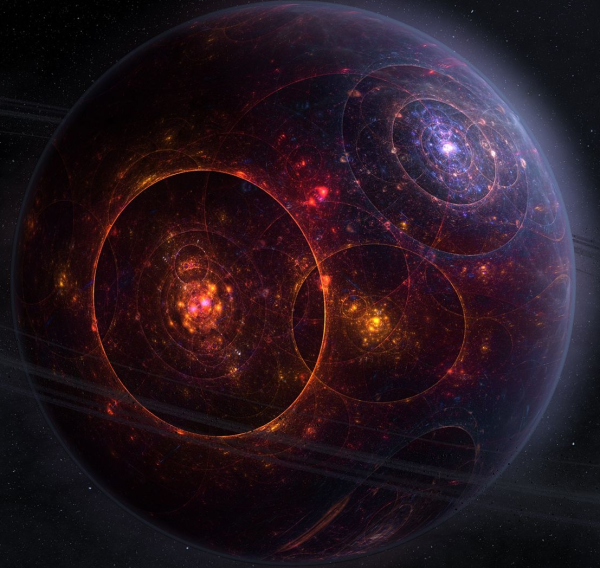 Image credit: the Xonotic forums of http://forums.xonotic.org/archive/index.php?thread-593-2.html, from user -z-.
Image credit: the Xonotic forums of http://forums.xonotic.org/archive/index.php?thread-593-2.html, from user -z-.
From Christopher on the search for ET: "The way we teach and frame our science gives the impression that our progress is smooth and builds on past progress in a continuous flow. This means that we expect the next big thing to somehow be contiguous with our current understanding. However, the actual progress we make is punctuated by sudden changes of direction."
This is often true, and that's why "surprise" is often the best thing. But I always hesitate to call out even the best "new, exciting ideas" because almost all of them are wrong, and most of the ones that aren't start off as demonstrably wrong, and need to be tweaked. I think it undermines the public understanding of science much, much more to call out, promote and glorify speculative, incorrect ideas much more than it does to give the correct, cutting-edge story of where we are today.
But if you want the speculative, you have your choice of where to go. It's practically all of science journalism today, from Popular Science to New Scientist to the Huffington Post. You don't have to read me if you don't like it.
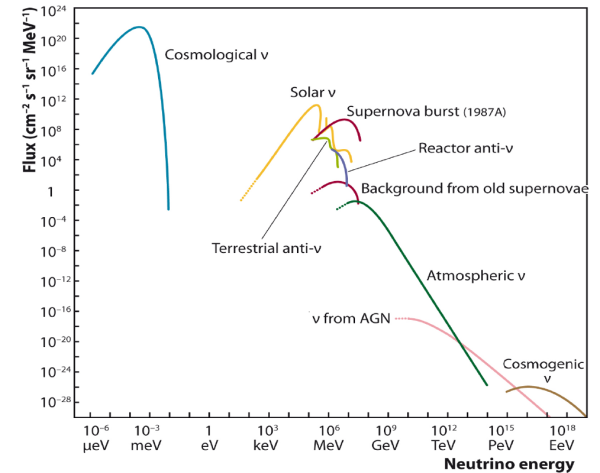 Image credit: IceCube collaboration / NSF / University of Wisconsin, via https://icecube.wisc.edu/masterclass/neutrinos. Note the unique signal of “reactor anti-neutrinos.”
Image credit: IceCube collaboration / NSF / University of Wisconsin, via https://icecube.wisc.edu/masterclass/neutrinos. Note the unique signal of “reactor anti-neutrinos.”
From Michael Kelsey on neutrino energy: "I also don’t see how you get a “specific energy” neutrino signal out. Lepton conservation requires that neutrino production is always a three (or more) body process, meaning that it has a continuous spectrum, with a high-energy cutoff (see the curves in your diagram)."
Although that's a good diagram, you probably want more neutrinos, and you probably want neutrinos that explicitly come from fusion reactions. Maybe something like this.
 Image credit: retrieved from http://lappweb.in2p3.fr/neutrinos/anexp.html.
Image credit: retrieved from http://lappweb.in2p3.fr/neutrinos/anexp.html.
But what's interesting from this is if we look at neutrinos on Earth, we already -- at least on our world -- are dominated by neutrinos from reactors. Have a look for yourself!
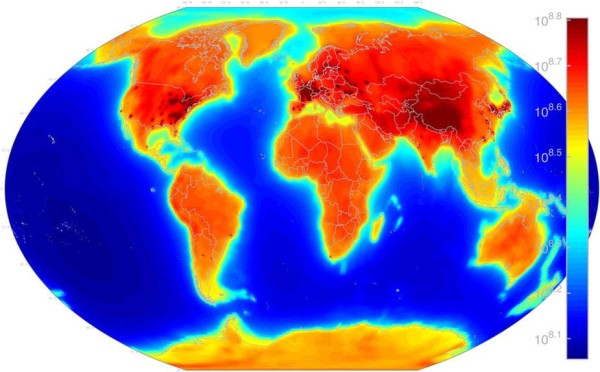 Image credit: Science Friday, via https://twitter.com/scifri/status/644951398849843200.
Image credit: Science Friday, via https://twitter.com/scifri/status/644951398849843200.
Those "hot spots" of neutrinos you see? Those are from terrestrial nuclear reactors. Now, I'm not saying that there will be a clear, easy unambiguous signal from a planet that has nuclear fusion on its surface, but if you get a large enough neutrino flux from a point source -- the star -- and from the planet going around it and you see that "bonus" neutrino signal, you're in business. That's a lot of neutrinos, but it's at least theoretically possible to do!
 Image credit: Circuit Scribe’s Kickstarter, via https://www.kickstarter.com/projects/electroninks/circuit-scribe-draw-c….
Image credit: Circuit Scribe’s Kickstarter, via https://www.kickstarter.com/projects/electroninks/circuit-scribe-draw-c….
From PJ on Circuit Scribe: "Given the resistance of the ‘ ink ‘ is about 10 ohms per inch, only the slowest of logic circuits MAY function with some success.
There is still no substitute for hard wiring a project. From this method, one learns patience, care in layout, the true value of components associated with the circuit, and the opportunity to fine-tune the function of the circuit."
Like any product, this one has its limitations, and those limitation -- as you suggest -- are severe. The whole major point of using this "draw your own circuit" technology is that building the simplest circuits becomes feasible. You don't need special paper, you don't need special tools, you don't need to mess with wiring. All you need is a connection from the battery to the element, and you're good. But as you say, the range is limited.
Resistance isn't futile at all, my ST:TNG fans. It kills a circuit and drains a battery in short order, and even though we have four elements that are outstanding conductors -- silver, copper, gold and aluminum -- an ink-based conductor is still no match for a solid wire. Yet.
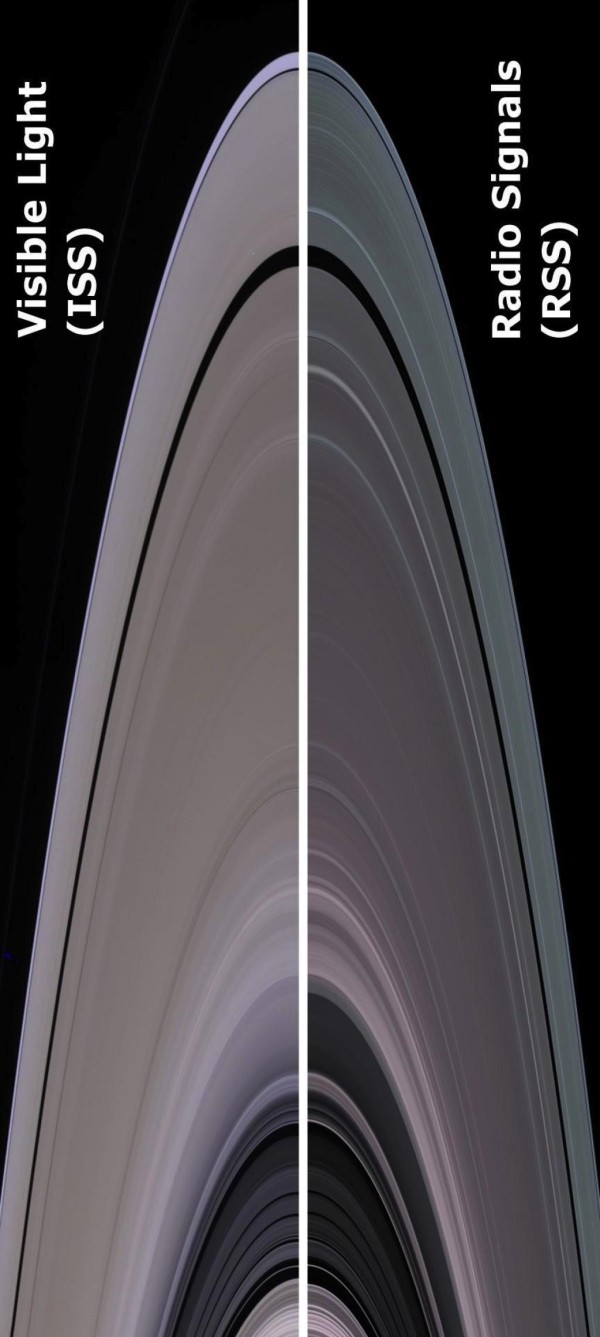
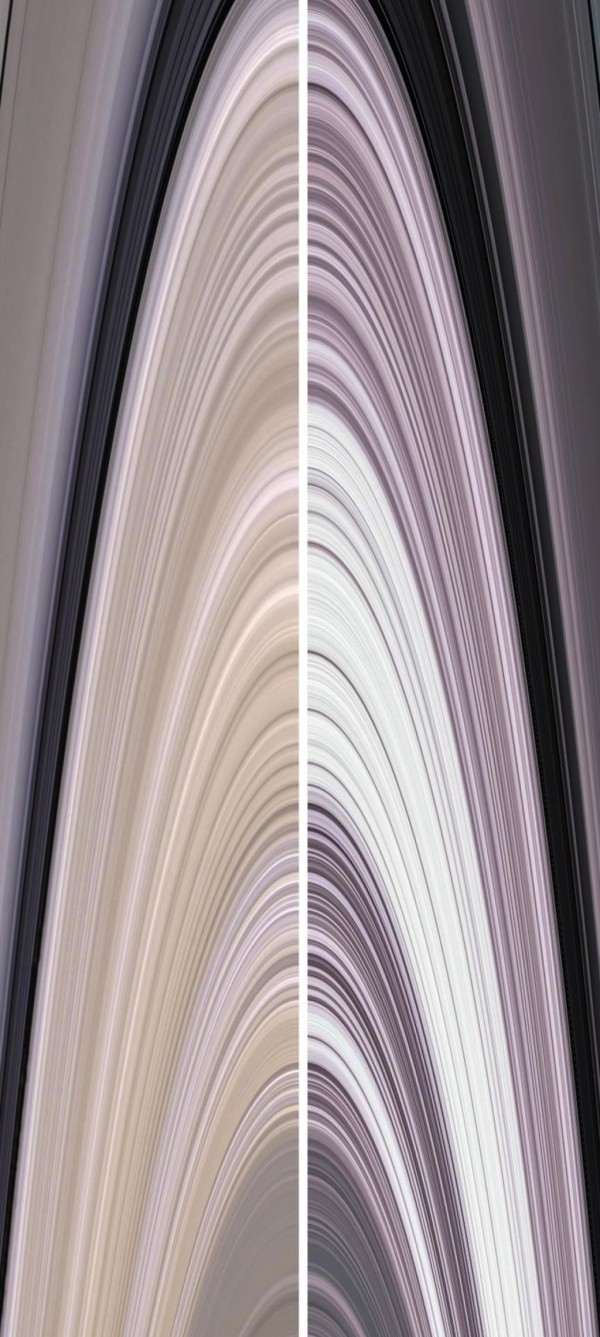
From Sinisa Lazarek on Saturn's rings: "Also on medium the photo of side by side comparison of rings in visible and radio… don’t know if ethan did it [intentionally].. but when scrolling it gives a nice optical effect of an [oscillator] making waves
"
Here's my best attempt to put those images (there are three) here on Scienceblogs for you to enjoy. It's pretty trippy, due to the effects that radio is more sharply defined, and also due to the fun angle-of-viewing that Cassini happened to be at when it took this data.
I couldn't put the image credit/caption in the photo in this format, so here it is: NASA/JPL/Space Science Institute, via http://photojournal.jpl.nasa.gov/catalog/PIA07874.
From G on the development of electromagnetism: "Were everyone from Oersted through Morse & Vail working on the basis of the prior Newtonian theory of electricity and magnetism? Or were they working empirically without having a clear basis in theory?"
The Oersted experiment, as you allude to, was done completely without having a clear basis in theory. Getting a "voltage pile" was a giant pain back in 1820, and so it wasn't known what the relationship was. Electric current was -- as outlined by Ben Franklin -- thought to be the motion of positive charges. The electron hadn't been discovered yet. And when the Oersted experiment first occurred, it was configured so that the needle began perpendicular to the current-carrying wire, thinking the needle would align with the wire when the switch was flipped.
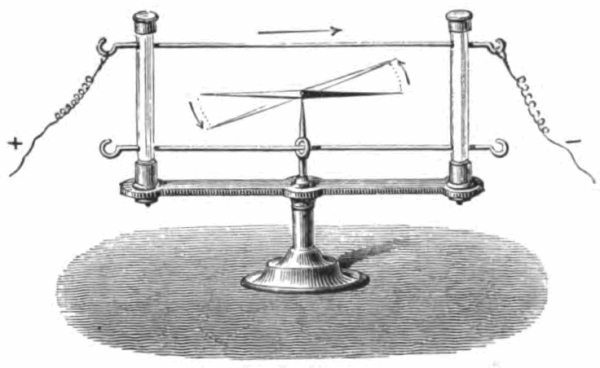 Image credit: Agustin Privat-Deschanel 1876 Elementary Treatise on Natural Philosophy, Part 3: Electricity and Magnetism, 1876.
Image credit: Agustin Privat-Deschanel 1876 Elementary Treatise on Natural Philosophy, Part 3: Electricity and Magnetism, 1876.
To say "there was no clear basis in theory" is a tremendous understatement. Electromagnetism came about in fits and starts: experimental results happened, theories were invented to explain them, tested, most were discarded, and a few stood the test of time. That's why named like Coulomb, Ampere, Faraday, Gauss and Maxwell have stuck around for so long: they happened to get it right. As far as I'm aware, there was no Newtonian theory of electromagnetism, at least, not one that history remembers.
Image credit: Nature, via http://www.nature.com/news/astrophysics-fire-in-the-hole-1.12726.
From Michael Hutson on quantum theory: "Does this apply even to wave function collapse? I thought that was considered thermodynamically irreversible by definition."
There is a fundamental symmetry of nature that applies to all quantum system: T-symmetry, which is sometimes known as time-reversal symmetry. It doesn't mean that it should be possible to unscramble an egg, but rather that every individual interaction that took place in the process of scrambling an egg -- every interaction between two particles -- is reversible. When you say "wavefunction collapse," you're talking about a single, measurable outcome, which is a particle interacting with the one you're trying to measure. That's all, and it conserves T.
There are, mind you, T-violating interactions in the weak interaction, but that's not what you're referring to here. The T-violating ones also violate CP (charge conjugation and parity), so that the combination of all three -- CPT -- is still conserved. That's a fundamental conservation law of the standard model. But what you're talking about are things like electromagnetic interactions, and they all conserve not just the combination of CPT, but C, P, and T individually.
Also worth reading is Michael Kelsey's answer to collapse (excerpted here):
"A quantum system evolves unitarily and reversibly according to the Schrodinger equation (if non-relativistic) or the Dirac and Klein-Gordon equations (if relativistic). The wavefunction does what it does based on the kinetic and potential terms in those equations, and always describes (when squared) a probability distribution of possible measurement results."
And we'll do one more on black holes, which this post was all about.
From Robert Elston on black hole evaporation: "I have never understood how Hawking radiation makes a black hole evaporate. The virtual particle pairs form near the EH, one is captured and the other escapes. Isn’t that zero sum?"
When you say "virtual" pairs, it's understood that they don't have things like "real energy" to them; that's one visualization or interpretation of the energy inherent to the vacuum of space. In reality, the region of space just outside the black hole emits energy, while the event horizon shrinks. I made a diagram that explains it better than usual with virtual particles; I've attached it below.
As you can see, there's no "lost energy", but rather in order to get two real photons (with real, positive energy), you need to take it from somewhere, and that "somewhere" isn't from empty space for free, but from inside the black hole's event horizon. That's where it comes from, and why they lose mass.
From Ross Presser on galaxies beyond Hubble's limits: "In the medium.com article you mentioned “Hubble’s photographic plates.” It doesn’t have them, does it? There’s no glass plates with chemical emulsions on them, right? It’s all digital nowadays."
Of course that's absolutely right, and we're incredibly thankful that's correct! We live in a digital age where literally every photon counts, and that's why we can do interesting things by doing multiwavelength analysis of intergalactic space. Photons coming from the extragalactic background are just as meaningful as the ones coming from galaxies, in their own way.
I should have said "Hubble's photographs," so that's a throwback to me using outdated vocabulary for a newfangled technology. I do that a lot in colloquial conversation, but I'll try and be mindful to be more precise when it comes to the science.
And finally, from BirgerJohansson on the Oort cloud: "Going off on a tangent, Jupiter has thrown out a lot of ordinary rocky asteroids into the Oort cloud,
While fewer than the “proper” comets -4%- their total mass may be as much as one third of Earth’s mass -far more than the current mass of the Main Belt!"
The MNRAS paper is here (via Michael Kelsey), but you can get the paywall-free version from arxiv.org here. As Wow suggested in the comments, the vast majority of asteroids that interact with the planets -- including Jupiter -- will either impact the Sun or be ejected into interplanetary space. But some of them remain active, and many of the ones that remain active will remain active in the Oort cloud, with very large semimajor axes. Here's the relevant figure.
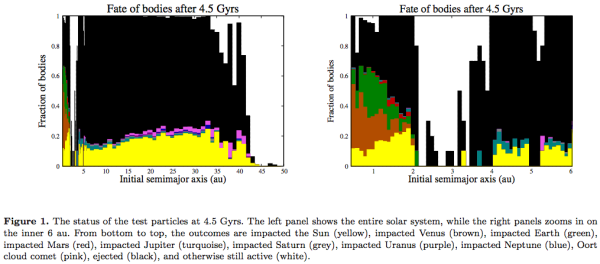 Image credit: A. Shannon et al., via http://arxiv.org/abs/1410.7403. Click for a larger version.
Image credit: A. Shannon et al., via http://arxiv.org/abs/1410.7403. Click for a larger version.
As you can see, there's a large bombardment of Earth that happens early, and most "test particles" do get ejected. But to quote from the paper itself:
[...] ~4% of the small bodies in the Oort cloud should have formed within 2.5 au of the Sun, and hence be ice-free rock-iron bodies. If we assume these Oort cloud asteroids have the same size distribution as their cometary counterparts, the Large Synoptic Survey Telescope should find roughly a dozen Oort cloud asteroids during ten years of operations. Measurement of the asteroid fraction within the Oort cloud can serve as an excellent test of the Solar system's formation and dynamical history.
So if this simulation is correct, Birger has it right. Pretty interesting... but as Michael also said, the Nice model talks about planetary migrations, and this paper has fixed planets (not migrating ones) in their simulation, which may make the whole analysis of questionable validity. But it's an interesting first step nonetheless.
Thanks for a great week of comments, and can't wait to see you back here for more next week!

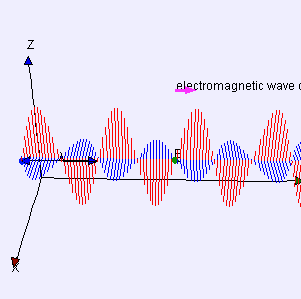
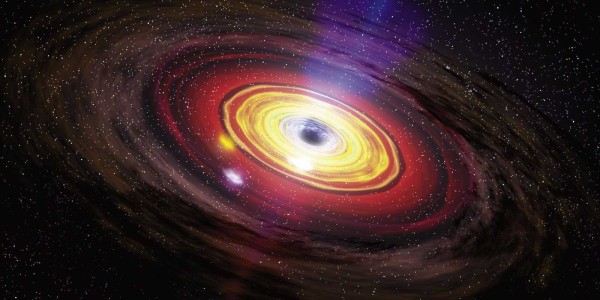
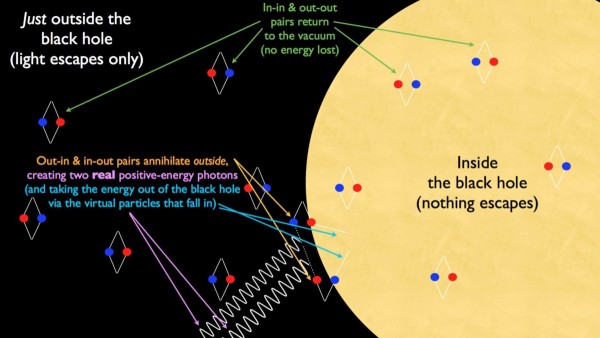
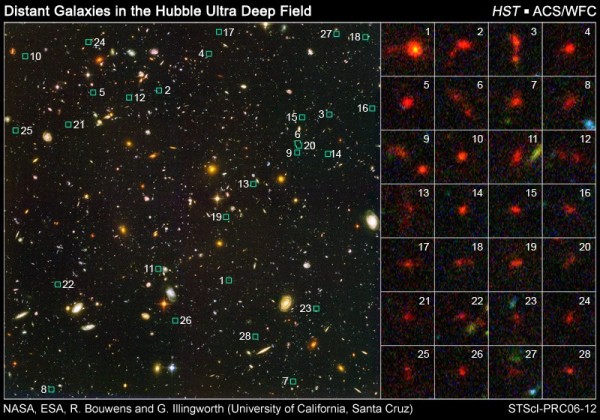
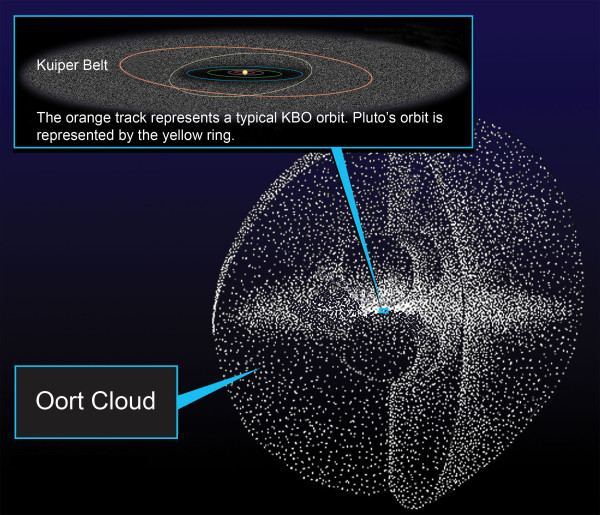
"Here’s my best attempt to put those images (there are three) here on Scienceblogs for you to enjoy. "
Thanks Ethan, you do a fabulous job with image rendering on the site. You should consider doing an image portfolio only complementary blog because you are very good at it.
If the Hubble had used photographic plates, would we also have a drive-though Fotomat in orbit? Who could be hired to work the window?
@Ethan: Another user mentioned this on the original article... That animated GIF you show of an EM wave is wrong in a basic way. The E and B fields should be out of phase by 90 degrees; that is, when the E field crosses the axis, the B field should be out at its maximum/minimum, and vice versa.
The reason is obvious: when either field is at an extremum, it is "not changing" (zero derivative), and therefore the complementary field should have zero magnitude.
Ethan, I envisioned my comment as a counterpoint rather than a challenge. I have read your work for years and will continue to follow. I see you on the cutting edge and often a corrective to my yearning for the science fiction and fantasy that hums along from my childhood. I yearn for the fantastic. You have me there. I just feel strongly nearing seventy, that what was true in fifties has been surpassed now in the teens, and this will continue to happen. Very few got it right. The computer thing took most of us by surprise.
Oh yes. I should also add, stuff we thought sure was coming has turned out to be more complex and difficult than we had hoped - meaning those of us keeping track. I mean of course the space programs. Back in the fifties some writers were speculating all the way to interstellar travel by now.
@Micheal Kelsey #2,
You raise an interesting point.
If one does a google search for images, searching voor 'electromagnetic wave', all the pictures and animations one finds show the electric and magnetic field vectors changing in phase, just as in the animation that Ethan used. What gives? The conclusion must be that the usual depiction is an oversimplification, and that something crucial has been neglected.
As described in the story about Maxwell's unification, historically electicity and magnetism were perceived as distinct phenomena. Our mental models still reflect that. My guess is that in the case of an electromagnetic wave the electric/magnetic distinction no longer has any meaning. The usual depiction is some approximation of what the equations describe, but as Michael Kelsey points out, the simplified picture is fatally inconsistent.
Fatally? Depends on what you want to do with it.
Use it to show THAT they vary together, co-dependently? Non fatal. HOW they vary? Yes, it's entirely wrong on that score.
The unfortunate bit is that this is so easy to fix and doesn't harm the illustration at all.
I goofed when I wrote about the E-field and B-field animation. I had the wrong analogy in mind.
We have that when a current is induced the current strength is proportional to the rate of change of magnetic flux. If something like that would be the case for the co-dependency of the E-field and the B-field in electromagnetic waves then one would expect that 'when the E field crosses the axis, the B field should be out at its maximum/minimum, and vice versa'.
I'm now satisfied that the co-dependency of the E-field and B-field isn't like that. That is, I'm now satisfied that the depiction of the E-field and B-field increasing and decreasing in phase is physically correct.
I suspect the first step would be unifying Luboš with Stanislav Grof.
Get right on it, then Narad.
Oh, and what's the next step, that will make communication by entangled pairs possible, Narad. I did ask how, EXACTLY, we should do this.
Don't just magicman the answer with nothing better than "We solve the problems with the idea of using entanglement". It rather begs the question that they CAN be solved to arrive at a way of sending messages faster than light.